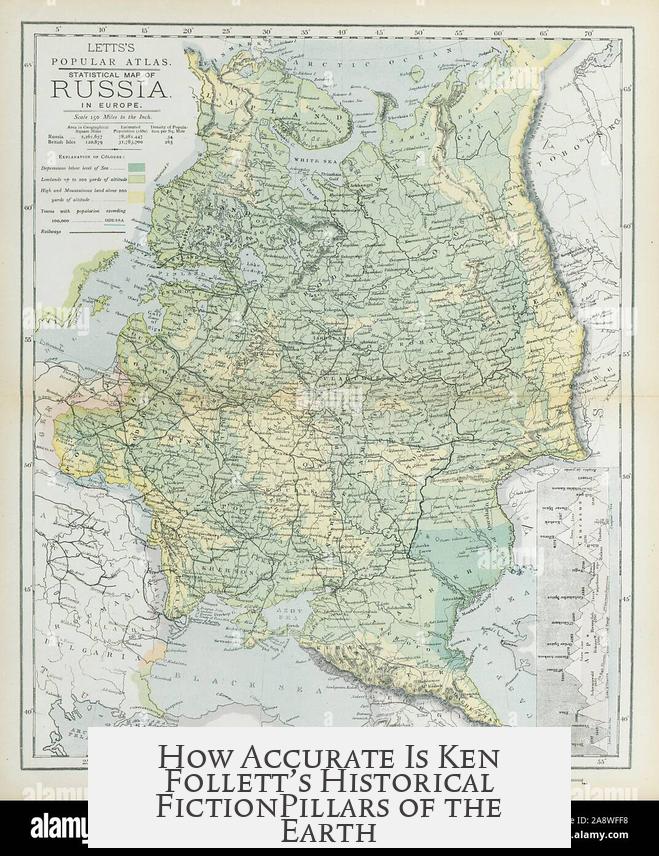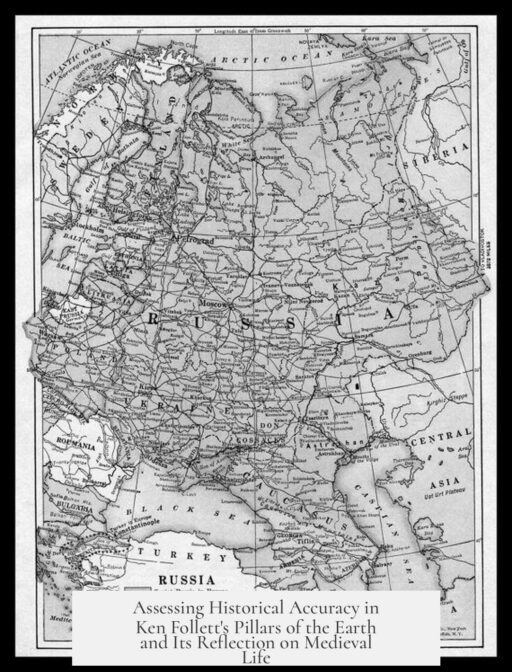Ken Follett’s historical fiction Pillars of the Earth presents a generally accurate depiction of 12th-century architecture and medieval life, though it simplifies or glosses over some historical details and includes a few anachronisms.
The novel accurately reflects key aspects of Gothic architecture, especially the influence of the Abbey of Saint Denis near Paris. Saint Denis is widely recognized as the birthplace of Gothic cathedral building. Follett correctly portrays how craftsmen trained there spread revolutionary techniques, such as rib vaulting, across Europe. These masons formed a crucial link between French innovations and English cathedrals. For example, the novel’s depiction of masons at Canterbury Cathedral draws inspiration from William of Sens, the French architect who introduced new styles to English building projects.
However, some architectural details are simplified or historically debatable. Durham Cathedral features prominently but its early use of vaulting challenges the timeline of Gothic advancements. While Durham had impressive vaults early on, it lacked flying buttresses. Flying buttresses allowed walls to support larger windows, a hallmark of High Gothic style emanating from Saint Denis. The novel somewhat overlooks this technical gap. Winchester Cathedral, shown in the story, underwent significant rebuilding after the time period depicted, so some elements represent later developments more than the actual 12th century.
Follett often uses rib vaults as a shorthand for Gothic architecture. Yet, rib vaulting existed in pre-Gothic traditions, and Gothic style includes a broader range of structural and decorative details. This approach streamlines architectural complexity for narrative clarity but reduces nuance.
- Saint Denis inspired cathedral techniques spread by skilled craftsmen
- Durham’s vaulting predates flying buttresses and larger windows
- Winchester Cathedral’s rebuild occurred after the story’s era
- Rib vaults simplify, but do not fully define, Gothic style
Regarding social and daily life, the novel captures the general atmosphere of medieval England but condenses realities. London was the largest city then, but it was not a vast metropolis. Roads were unreliable, and most people rarely traveled far from their local market towns or villages. London’s broader trade network and metropolitan expansion only developed significantly in the 16th century, well after the novel’s setting.
Privacy was limited during this era. Bedrooms were rare. Even noble families shared rooms with servants and relatives. Curtains might divide beds but did not ensure privacy. Medieval notions of bodily functions and sexual activity were more open to communal observation than modern sensibilities allow. Follett conveys this lack of personal privacy accurately.
Work structures lacked modern organization. The novel’s portrayal of people searching for work reflects a time before the development of social institutions. Guilds, apprenticeships, and family ties helped find employment rather than advertising or formal labor markets. The concept of organized labor strikes is historically inaccurate; strikes as a form of protest did not exist in this period.
Last names were inconsistent. Many surnames derived from trades but were not universally recorded or stable. Follett fairly represents this naming instability.
- London was big but not metropolitan; towns were local centers
- Shared bedrooms and low privacy were common
- Work was informal; strikes did not occur
- Surnames varied, often linked to trades, without strict rules
The novel introduces certain anachronisms. Most notably is the concept of credit, which medieval society condemned as usury and viewed as sinful. Follett’s depiction of credit use by characters imposes a modern financial concept inaccurately onto the 12th century. Miracles in the book are sometimes explained through a materialist lens, contrasting with the period’s religious worldview that embraced the supernatural without skepticism.
In summary, Pillars of the Earth succeeds in capturing the essence of medieval architecture and society but trades some historical precision for storytelling. It conveys the major shifts in Gothic cathedral building and the social environment of the Middle Ages with reasonable accuracy. However, it simplifies naming conventions, social customs, and labor relations and includes implausible elements such as early credit and worker strikes.
Key takeaways:
- Pillars of the Earth accurately depicts the spread of Gothic architectural techniques from Saint Denis.
- Some structural details, especially regarding Durham and Winchester Cathedrals, simplify historical complexity.
- The novel realistically portrays medieval social life, including privacy limits and informal labor systems.
- It includes historical inaccuracies like the concept of credit and worker strikes that did not exist then.
- Overall, it balances narrative needs with a strong foundation in medieval history but omits some nuances.
How Accurate Is Ken Follett’s Historical Fiction Pillars of the Earth?

Let’s cut to the chase: Ken Follett’s Pillars of the Earth is fairly accurate on the architectural front but takes notable liberties with medieval social life and economic practices. If you’re curious about how true-to-history his depiction of cathedral building really is, and whether his take on medieval society rings true, stick with me as we peel back the stone façade.
When it comes to architecture, Follett is no slouch. He clearly does his homework. The novel captures the spirit of a crucial turning point in cathedral construction—the seismic influence of Saint Denis cathedral just outside Paris. This church is known for kicking off the Gothic revolution, ushering in flying buttresses and rib vaults that changed cathedral design forever.
The craftsmen in the story, many trained in France, reflect this influence accurately. For instance, the character inspired by William of Sens, who worked on Canterbury Cathedral, echoes real historical figures bringing new Gothic techniques to England. Follett uses “rib vaults” as a neat shorthand for Gothic architecture, even though rib vaults existed before the Gothic era and other features define the style.
However, some details are, let’s say, architecturally forgiving. Durham Cathedral, for example, certainly sports early vaulting but hasn’t wrapped its walls in flying buttresses during the novel’s timeline. That means large windows, a hallmark of Gothic grandeur, are technically out of place since buttresses support the walls, allowing for those glorious apertures. Winchester Cathedral, as it stands today, was rebuilt *after* the novel’s mid-12th-century setting, so its inclusion in the story is a stretch.
In short, Follett’s architectural canvas blends solid research with a splash of creative license. He nails the broad strokes and impressive influence of the Gothic revolution, even if he skips some subtle historical minutiae.
So, What About Social Life in Medieval Times?
Here the story gets fuzzier. Follett’s picture of medieval society shows moments of clarity but also some puzzling inaccuracies.
Take London, for example. Follett quite rightly portrays it as the largest city—but don’t imagine the sprawling metropolis we know today. In the 1100s, London’s influence barely stretched beyond nearby market towns. Roads were poor, travel was slow, and most medieval folk kept their worlds quite small. London only begins to resemble a true metropolis in the 16th century.
Privacy? Forget it. Bedrooms were rare and hardly private. Even nobles shared their rooms—curtains might have shielded beds but couldn’t hide bodily functions or romantic escapades. Medieval life didn’t obsess over personal space like modern times.
The labor scene might seem chaotic to us. Workers wandering about hunting for gigs sounds inefficient, but that’s what life was like without modern institutions. Advertising was non-existent—people leaned on family ties, guilds, and apprenticeships. Consumer society and its trappings, including ads, only emerge centuries later.
Speaking of social customs, last names were often tied to trades, but formal surnames weren’t always recorded consistently. It was a murky tapestry of naming conventions rather than a neat system we have now.
Where Follett Trips Over History
Some parts of the novel stretch credulity. The invention of credit as casually depicted? An anachronism. Credit, or usury, was condemned fiercely by medieval church teachings—its concept as we know it was socially taboo, not the norm.
Then there’s the portrayal of miracles. Follett’s lens is decidedly modern and materialistic, wanting to explain miracles in natural terms. This outlook clashes with the medieval mindset, where faith and the supernatural weren’t subjects for skeptical inquiry but core beliefs.
Lastly, the idea of a workers’ strike in the novel seems downright laughable from a historical standpoint. Labor unions and strikes are products of much later centuries. In the 12th century, organized labor action—especially in a form recognizable today—didn’t exist.
Should You Trust Pillars of the Earth as History?
If you want a thrilling story that brings the Gothic cathedral age to life with architectural passion, go ahead and dive in. Follett’s attention to how cathedral masons spread new building methods across England and France is commendable and vividly portrayed.
But when it comes to social norms, labor relations, economic systems, and medieval piety, take the novel’s depictions with a grain of monastic salt. It’s a story dressed in medieval garb but with 21st-century shoes peeking out.
Wondering how you can separate history from storytelling? Look for how Follett’s focus on craftsmanship and Gothic architecture aligns well with evidence. Then contrast that with the more modern-feeling social interactions and economic details that feel out of place.
Curiosity about medieval cathedrals? Check out the real Saint Denis or Durham Cathedral and compare them to Follett’s description. You’ll notice the story captures the essence of architectural evolution even while smoothing over technical gaps.
And if privacy intrigues you—whether lords and ladies truly had separate chambers—historical records show communal living was the rule. That’s a fascinating window into medieval life most fiction glosses over.
Final Takeaway
Ken Follett’s Pillars of the Earth blends solid architectural research with imaginative storytelling but bends historical accuracy on social and economic fronts. It excels as historical fiction by weaving fact and fiction to serve its plot and themes.
It’s like a well-built cathedral itself—a strong structure standing on a rich foundation but with some decorative elements added for flair. For readers hungry to learn, it inspires curiosity about medieval architecture while inviting a critical eye toward its fictional liberties.
Isn’t that what all good historical fiction should do?




